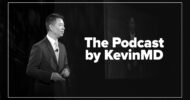Subscribe to The Podcast by KevinMD. Watch on YouTube. Catch up on old episodes!
Pediatrician Arti Lal discusses her article, “Why ADHD in women is finally getting the attention it deserves.” She explores why new ADHD diagnoses nearly doubled for adult women from 2020 to 2022 and the unique barriers they face in getting proper care. Arti explains how historical gender biases have led to misdiagnosis, as female hyperactivity often presents as internal racing thoughts or chattiness rather than the classic external restlessness seen in boys. The conversation delves into the significant, under-studied impact of hormonal cycles on symptom severity, from the menstrual cycle to menopause. To overcome diagnostic challenges and provide personalized care, Arti advocates for integrating objective, data-driven testing alongside subjective assessments. This approach not only provides a clearer clinical picture but also validates the lived experiences of women who may have internalized their symptoms as character flaws for years.
Careers by KevinMD is your gateway to health care success. We connect you with real-time, exclusive resources like job boards, news updates, and salary insights, all tailored for health care professionals. With expertise in uniting top talent and leading employers across the nation’s largest health care hiring network, we’re your partner in shaping health care’s future. Fulfill your health care journey at KevinMD.com/careers.
VISIT SPONSOR → https://kevinmd.com/careers
Discovering disability insurance? Pattern understands your concerns. Over 20,000 doctors trust us for straightforward, affordable coverage. We handle everything from quotes to paperwork. Say goodbye to insurance stress – visit Pattern today at KevinMD.com/pattern.
VISIT SPONSOR → https://kevinmd.com/pattern
SUBSCRIBE TO THE PODCAST → https://www.kevinmd.com/podcast
RECOMMENDED BY KEVINMD → https://www.kevinmd.com/recommended
Transcript
Kevin Pho: Hi, and welcome to the show. Subscribe at KevinMD.com/podcast. Today we welcome Arti Lal. She’s a pediatrician. Today’s KevinMD article is “Why ADHD in women is finally getting the attention it deserves.” Arti, welcome to the show.
Arti Lal: Thank you, Kevin. Glad to be here.
Kevin Pho: All right, so just briefly share your story and then talk about why you decided to write this article.
Arti Lal: I’m Dr. Lal. I’m a career pediatrician in Austin, Texas. I work for Baylor Scott and White, and I have been diagnosing and treating patients with ADHD, including children and young adults, for the past 14 years. It has been quite an interesting and fulfilling journey.
Kevin Pho: All right, and your article focuses on ADHD in women. Why did you decide to write this article?
Arti Lal: The purpose of writing this article was mainly because the landscape of ADHD has changed somewhat in the past few years. We have seen more and more women coming forward for assessment and diagnosis. The reason for that is the pandemic threw that door wide open. More and more people were isolating socially. There was more self-reflection. Family members were in close contact with each other.
There was a process of also accessing social media much more—Instagram, TikTok—and people were posting more about the topic. More and more girls and women started seeing themselves in the social media posts. This started them coming forward for getting professional assessments and help and advocating more for themselves that, hey, this could be ADHD, the lifelong symptoms that we have been suffering from. We actually saw the rate of ADHD in women—diagnosis and need for assessment—almost double from 2020 to 2022.
Kevin Pho: In your article, you talk about the presentation of ADHD being different in women versus men. How does ADHD present differently in women?
Arti Lal: ADHD is a complex disorder. In the most recent DSM-5, there are three types: a combined type with hyperactivity, impulsivity, and inattention; the hyperactive-impulsive type, which is actually quite rare; and the inattentive type. Now, both types can present in both men and women, boys and girls. But in women, particularly, the inattentive type tends to be more common.
Hyperactivity in women is slightly different from hyperactivity in men. Especially in boys, it is more apparent. They’re the usual rambunctious boys in the classroom. It’s very visible. They walk around the classroom and won’t listen to the teachers. But in girls, it is somewhat hidden in that they tend to be more restless, fidgety, and talkative, with rapid speech. And so this is not completely apparent to parents and teachers. The hyperactivity aspect differs a lot between girls and boys and men and women.
Kevin Pho: How do you assess ADHD in the exam room? In your article, you talk about perhaps some objective testing, but give us the approach of how you would diagnose ADHD when someone presents to you with potential symptoms.
Arti Lal: ADHD, as I said, is a complex disorder, more complex than I thought it was when I started this journey several years ago. The process involves, number one, taking a detailed history. The history includes educational history, medical history, history of the family, the family dynamics, then sleep, diet, exercise, and any other medical issues that you may have. So it’s quite a long clinical interview, and basically, you are looking for cause and effect. You’re looking for, hey, is this disorder truly the ADHD the way I understand it, or is this something that is coming from something else?
For instance, I’ll give you an example. Last year I had a patient, a 13-year-old, who had a lot of recent weight loss, was very hyperactive in the classroom, had a lot of tremors, and was very restless, which he was not six months ago, and he turned out to have thyroid issues. So you really have to be a detective looking for all kinds of things that may aggravate ADHD, cause secondary ADHD, or may or may not be ADHD.
Secondly, we do some rating scales: anxiety rating scales, depression rating scales, and rating scales that are appropriate ADHD-wise depending on the age of the patient. Then we add in other rating scales, like for eating disorders or OCD, depending on the history, whatever is present, again, to rule out cause and effect.
Lastly, objective testing is basically a 20-minute computerized test that we do that gives us a measure of and a very visual and data-driven measure of exactly how your attention is and how much impulsivity and movement you have when you’re given a task. It has been an extremely useful tool to graphically show the patients and to tease out overlapping diagnoses. It’s also helped with treatment. You can put the patient on medication, you can repeat the test and actually see the changes.
Kevin Pho: One of the things that I found interesting about your article was a link between estrogen levels and ADHD symptoms in women. So can you walk us through how these symptoms might change for a woman throughout a menstrual cycle?
Arti Lal: Surprisingly, estrogen is produced by the brain itself, not just the ovaries, and the estrogen that is produced from the cholesterol in the brain is responsible for the regulation of dopamine receptors, regulation of serotonin, and norepinephrine. Hence, you can imagine what happens when estrogen goes up and down. It can affect women in three or four phases of their lives.
So, imagine a young woman who’s having a menstrual cycle. In the post-luteal phase premenstrually, when her estrogen drops and progesterone goes up, you’ll definitely see inattention, memory issues, and cognitive decline. And they say that girls and women with ADHD are affected more than the general population of women.
Also, in the postpartum phase, it’s speculated—we really don’t have the research, and the research is being done now by several ADHD researchers—what they say is that postpartum depression is more common in women with ADHD. Perimenopausal symptoms in women who have ADHD include much more brain fog, attention and memory issues, and mood issues. So I think hormones have been entirely left out in 50 percent of the population, and we are only coming to that now. I’m very glad we are.
Kevin Pho: Now, do you think the way that we screen and diagnose for ADHD needs to be adjusted so we can ask more gender-specific questions to screen girls who may have been missed by traditional methods of screening?
Arti Lal: What we see in the previous rating scales—and the rating scales have evolved in the sixties, seventies, and nineties—is a good example. I was looking at an older rating scale, the Conners Rating Scale, which had about 59 questions, and only seven questions were devoted to inattention. The questions are not specific to circumstances that you see in day-to-day life. They were very general. So it really misses that huge part of ADHD which is present in girls, that is, inattention. So a lot of work is being done in that area. I’m part of one or two of those studies where we are trying to find more and more tools so that we don’t miss this in girls and women.
Kevin Pho: What about the treatment of ADHD? Are there any differences in terms of how we treat ADHD in girls versus boys?
Arti Lal: Generally, over the past several years, treatments have by and large been the same. Treatment includes psychoeducation, which is a tremendous one, stimulant medications, and non-stimulant medications. Studies have not shown any differences in effects on girls and boys and men and women. They have the same effects. Non-stimulants have really come into the picture in a big way in the past few years.
But going forward, the way we can help girls and women more is by paying attention to their menstrual cycles, the phase of the menstrual cycle, and their hormones, basically. So we can now craft treatments. We have already started doing that. There was a report that women had already started varying the dosage of the stimulants in different phases of their menstrual cycle themselves and not telling their clinicians.
So, you are absolutely right. We can do hormonal replacement therapy. Some women have even gone on HRT for three months at a time so that you don’t have a period, so you don’t have the inflections of the hormones. You can also add a small dose of SSRIs. You can vary the dose of the stimulants. There is absolutely a lot that can be done now.
Kevin Pho: So you’ve seen some women vary the dose of their stimulants based on where they are in their menstrual cycle?
Arti Lal: Not myself, but there are reports of that.
Kevin Pho: Now, how do you counsel women during their menstrual cycle in terms of managing their ADHD symptoms?
Arti Lal: I have to admit, Kevin, this has started only recently because all this is coming to light recently. I wish I had known this before and had all this knowledge and thought about it and known more about the effects of estrogen on the female brain. But now I have started talking to them about charting their symptoms, giving me feedback about if they have cognitive changes, memory issues, and more inattention. Then I add a small dose of a short-acting stimulant to help them through those days.
I haven’t delved into HRT yet. But I think that would be a good one where if a woman is already on birth control, instead of her doing a 28-day cycle, then coming off it and having a period, I can probably put her on a three-monthly, 84-day cycle and avoid that dip down in her cognition.
Kevin Pho: Another point that you’re raising in your article is the lack of data or research in ADHD medicine during pregnancy. So how do you counsel women who have to manage their medications and are pregnant?
Arti Lal: There is some data that has come out recently that some stimulant medications may be safe during pregnancy. Like I said, Kevin, in the past when I’ve had young women who were pregnant, we didn’t have enough data about how safe these medications were. I would definitely tell them, “Please avoid them in the first and second trimester. We don’t know about fetal malformations, et cetera.” In the third trimester, maybe if they were really having a difficult time, we would do it as needed, and only a short-acting one so that the half-life is short and it gets out of your system quickly.
But now there is some data coming out about certain medication, mostly in the methylphenidate group, that may be safe to use. The way that ADHD affects some of these women, where symptoms are quite severe, it can really derail their lives. We really have to rethink medications during pregnancy in women with ADHD.
Kevin Pho: We’re talking to Arti Lal. She’s a pediatrician. Today’s KevinMD article is “Why ADHD in women is finally getting the attention it deserves.” Arti, let’s end with some take-home messages that you want to leave with the KevinMD audience.
Arti Lal: ADHD for a long time has been trivialized and stigmatized in both men and women, and more so in women. We need more and more training for physicians, especially primary care and ADHD specialists, to see how ADHD affects women differently than men. We also need more tools to diagnose ADHD in women and specific to their circumstances.
I would say this to clinicians: please start asking your patients about their symptoms if they have ADHD and you’re prescribing their medications and just doing medication follow-ups. This is very important.
Having done ADHD for so many years and seeing the weight change during the pandemic and how many women are coming out, I would at some point advocate even for universal screening for ADHD. We do universal screening for depression these days. We have to be more intentional about finding these patients, treating them, providing equitable care, and especially following up on accommodations with employers and being aware that this is covered under the Americans with Disabilities Act. Very small accommodations can have a huge impact on patients’ lives.
Kevin Pho: Arti, thank you so much for sharing your perspective and insight, and thanks again for coming on the show.
Arti Lal: Thank you. Thank you, Kevin. Bye.


























